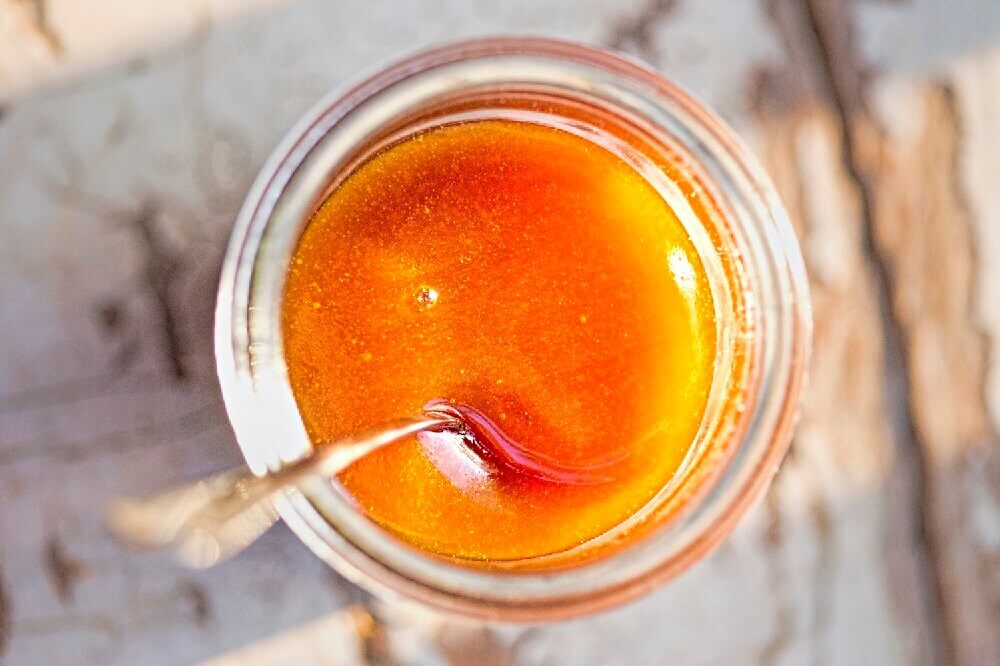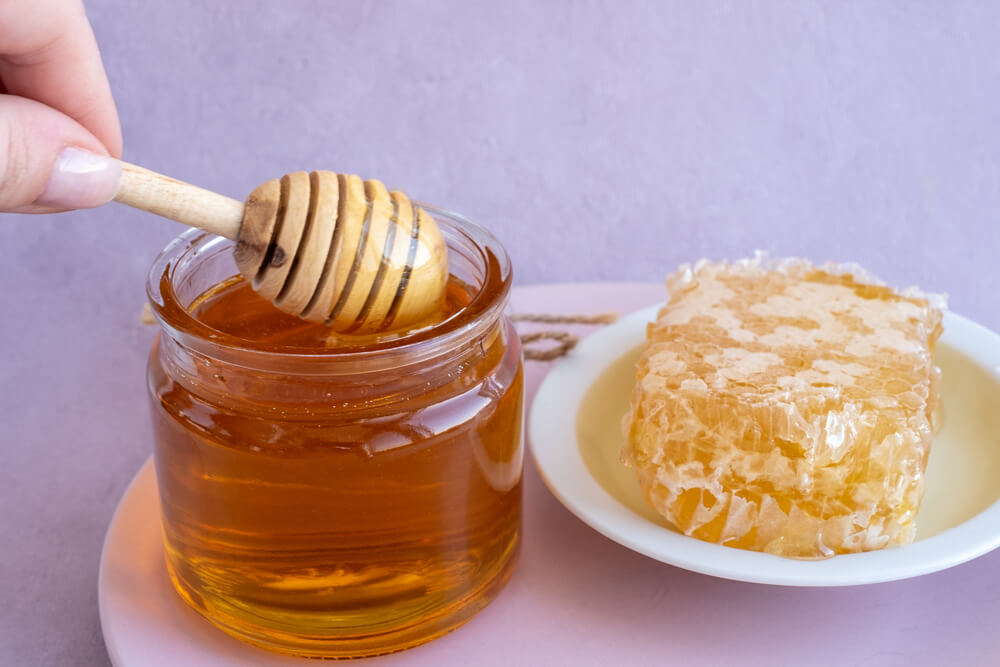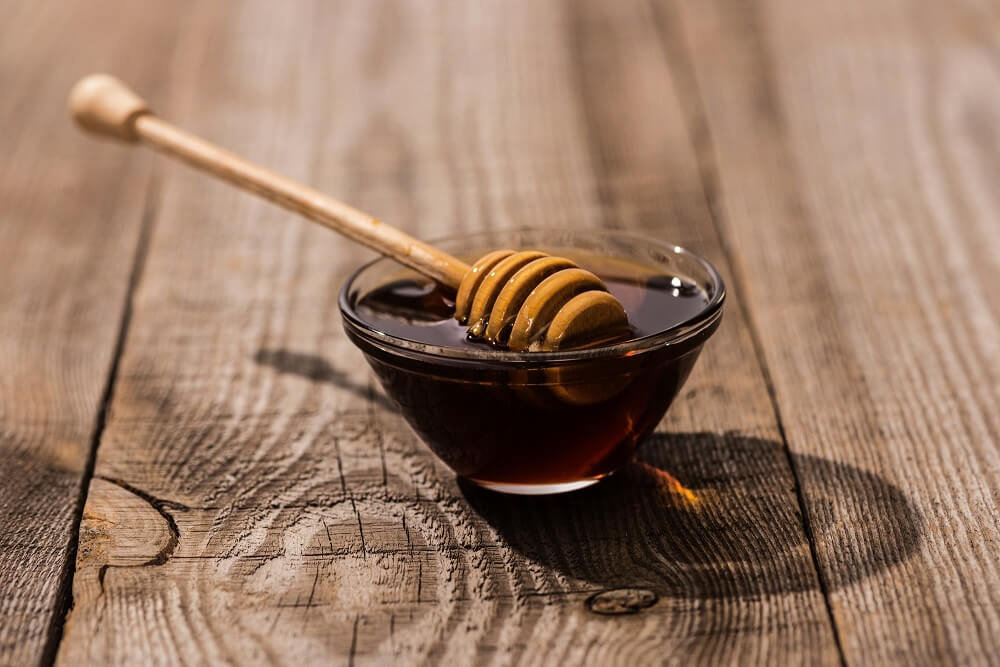Table of Contents:
Is Honey Acidic or Alkaline?

Honey is considered acidic because it has a pH that falls in the range of 3.4 to 6.1. On average, the pH of honey is 3.9.
pH is measured on a scale of 0-14. The number signifies whether the item is acidic, alkaline, or neutral.
The pH scale is:
- Acidic: 0.0–6.9
- Neutral: 7.0
- Alkaline (or basic): 7.1–14.0
Honey falls into the acidic range because it has an average pH of 3.9. For comparison, honey is less acidic than lemons. Lemons have a pH of around 2, which is highly acidic and explains why they’re sour.
And here’s the interesting part:
There are more than 300 flavors of honey, and they can each vary in pH. So while honey is considered acidic as a whole, some types of honey are more acidic than others.
Take orange blossom honey, for example.
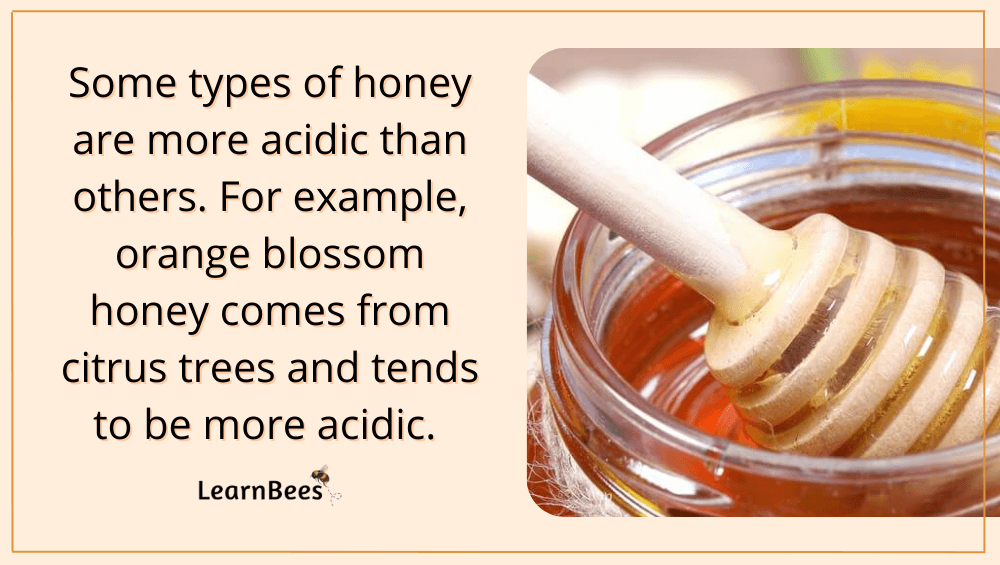
The pH of orange blossom honey falls between 3.62 – 3.8. Citrus fruit is known for being acidic, and in turn, citrus flowers produce a more acidic honey compared to other honey types.
Orange blossom honey comes from honeybees that collect nectar from citrus trees. It has a delicate and sweet flavor with notes of citrus.
On the other hand, chestnut honey is less acidic than orange blossom honey. Chestnut honey has a pH of about 5.4.
But here’s something that might surprise you:
Despite being acidic, honey can actually “soften” the sour taste of other acidic foods. For example, honey and lemon are a popular combination for tea. Honey softens the sour taste of the lemon and adds a touch of sweetness.
Interestingly enough, honey can become more acidic as it ages. This happens during the fermentation process.
Fermented honey (often called baker’s honey) has a higher moisture content than most honey. This lets the natural yeasts and enzymes start the fermentation process. Moisture and warmth kick-start fermentation.
So if you’ve ever left a honey jar lurking at the back of a warm cabinet only to find a ‘honey explosion’ later on, you may have accidentally fermented your own honey.
Does Honey Make Your Body Acidic?

You shouldn’t be worried about the acidity of honey on your body. As mentioned, honey falls into the pH range of 3.4 to 6.1.
Numerous other foods also fall within this range:
- Oranges: 3.0 to 4.0
- Cherries: 3.2 to 4.0
- Bananas: 4.5 to 5.2
- Carrots: 4.9 to 5.3
- Cauliflower: 5.6
- Potatoes: 5.4 to 5.9
- Corn: 6.0 to 6.5
The human stomach contains hydrochloric acid, which is highly acidic. It has no issue handling the acidity of the honey.
So, in a nutshell:
There is no research suggesting that acidic foods like honey are harmful to your health.
It’s impossible to alter the blood’s pH through diet alone. Although your diet can affect the pH of your urine, research typically shows that eating alkaline or acidic foods is unlikely to have a big impact on the pH level of your blood.(1)

In fact, increased levels of acid in your blood are typically a result of an underlying medical issue like lung disease, kidney problems, or diabetes that’s not well managed.(2)
Individuals who are most likely to benefit from a reduced-acid diet are people that deal with upper gastric disorder or symptoms when eating acidic foods.
And keep in mind:
Different parts of the human body have their own pH levels, just like different foods do.
Your ideal blood pH falls within a range of 7.35 and 7.45, which is slightly alkaline. The stomach is acidic at a pH of about 3.5, which helps to digest food correctly.
Eating high acidity foods within reason is part of a balanced and healthy diet.
For example, nutritionists recommend eating many vegetables and fruits daily. These foods, which are oftentimes acidic, are good for your overall health.
Does Honey Stop Acid Reflux?
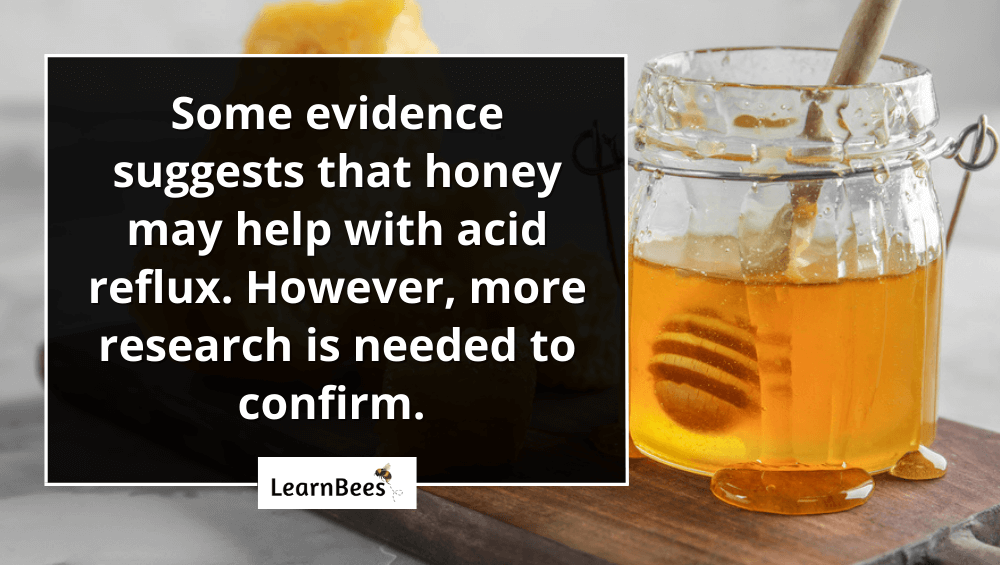
Honey may work in multiple ways to reduce acid reflux symptoms.
According to the American College of Gastroenterology, over 15 million Americans deal with heartburn daily. Heartburn is a common result of acid reflux, a condition in which acid moves from the stomach back up into the esophagus and sometimes the throat.
Acid reflux can be painful and disturb sleep or daily activities.
The Indian Journal of Medical Research published an article noting these key benefits of honey for acid reflux:(3)
- Honey scavenges both antioxidants and free radicals. Free radicals are a type of molecule that may cause reflux in part by damaging cells lining the digestive tract. Honey may protect against damage by neutralizing free radicals.
- Honey has the potential to reduce inflammation in the esophagus.
- Honey’s sticky texture helps it better coat the mucous membrane of the esophagus. This can give people longer-lasting relief.
- Honey is a natural remedy that can be used alone or in combination with other traditional treatments.
While this research is a step in the right direction, more formal studies need to be conducted to truly assess the effectiveness of honey as a treatment for acid reflux.
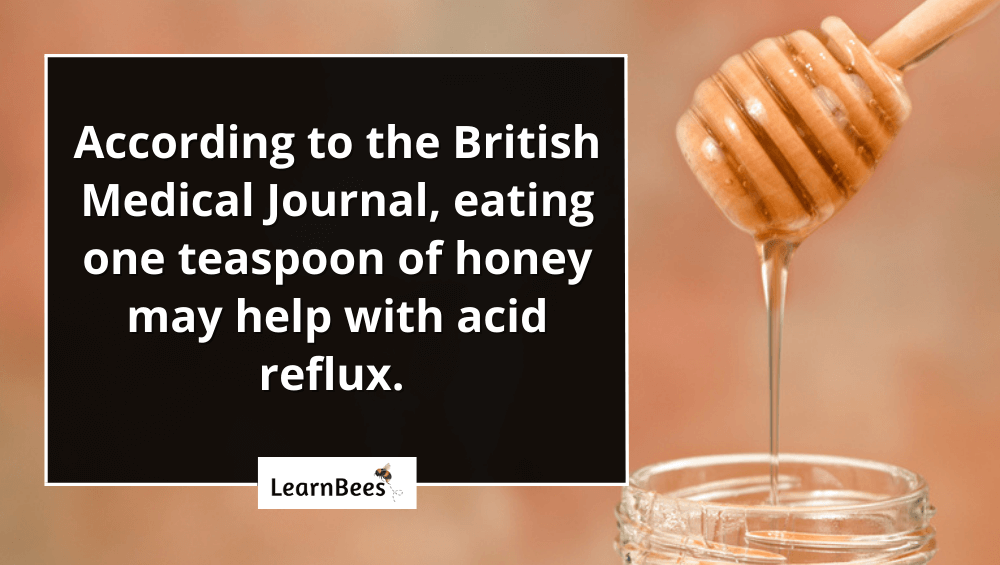
As suggested by a clinical review published in the British Medical Journal, honey’s viscous texture might help keep acids at bay. One individual on their team decreased their heartburn symptoms after consuming approximately one teaspoon of honey.
The researchers suggest that honey’s sticky texture helps to keep acid down.
If you don’t want to take one teaspoon of honey alone, combine it with a glass of warm water, tea, or coffee. Drinking a glass of milk or eating yogurt may also provide soothing relief.
Honey is typically safe to consume, but because it contains natural sugars, take caution if you have a blood sugar condition like diabetes.
Also, children under 12 months of age should not eat honey because it can lead to infant botulism. Once the child is over 12 months, their immune system has matured, and they can eat honey
FAQs on “Is Honey Acidic?”
- Why is honey so acidic?
- Does honey help with acid reflux?
- Is honey good for your stomach?
- Can I eat honey with other acidic foods?
- Is manuka honey acidic?
- What’s the pH of honey and water?
- What’s the pH of honey and lemon?
- Is honey alkaline?
Why is honey so acidic?
The pH level of honey is affected by the type of flowers the bees gather nectar from, as well as the honey’s moisture content and storage conditions. However, honey’s pH level is typically between 3.4 and 6.1, making it acidic.
With that in mind, plenty of foods are more acidic than honey. For example, lemon, limes, and other citrus fruits are more acidic than honey.
The fact that honey is acidic shouldn’t be a cause for concern.
Honey has an acid level considered low enough to stop the growth of microorganisms. For this reason, honey has often been used as a topical and oral antibiotic.
For example, raw honey is considered a powerhouse ingredient for the skin because of its antifungal, antibacterial, and anti-inflammatory properties. Honey has been used to treat many things, such as minor acne spots to serious skin concerns like diabetes-related foot ulcers.
In fact, honey was found in one study to effectively heal partial-thickness burns and infected wounded after surgery.(4)
Honey was also found to have a 97% success rate in treating diabetes-related foot ulcers in another research study. Such foot ulcers are serious and could lead to limb loss.(5)
In addition, honey has been shown to help treat other skin problems, including herpes, eczema, and psoriasis.(6, 7, 8)
—> Go back to the FAQs on “Is Honey Acidic?”
More to Explore:
- Honey Pasteurization: Does it Ruin Raw Honey?
- Honey for Skin Benefits: Directions, Uses, & Risks
- 8 Scientific Benefits of Raw Honey
Does honey help with acid reflux?
Some evidence shows that honey may help reduce acid reflux and heartburn symptoms.
The American College of Gastroenterology reports that over 15 million Americans struggle with heartburn daily. Heartburn is a symptom of acid reflux. Acid moves from the stomach back up into the esophagus and sometimes even the throat.
Acid reflux can cause significant discomfort and interfere with normal daily activities and sleep.
Honey may be used to treat acid reflux in several different ways. According to an article published in the Indian Journal of Medical Research, here are some of the major advantages:
- Honey scavenges both free radicals and antioxidants. Free radicals are molecules that may cause reflux partly by damaging the cells lining the digestive tract. Honey may protect against free radical damage by neutralizing them.
- Honey has the potential to reduce inflammation in the esophagus. Inflammation is a common problem that can cause pain and discomfort.
- The stickiness of honey aids in coating the esophagus, providing better and longer-term relief.
- There are many benefits to using honey as a natural remedy, including its ability to help fight infection and speed healing. Honey can be used alone or in combination with other traditional treatments for the best results.
However, while this study is a step forward, more rigorous research is required to determine the efficacy of honey as a treatment for acid reflux.
According to a clinical examination published in the British Medical Journal, honey’s thick consistency may aid acid neutralization.
Honey is typically fine to eat, but because it has natural sugars, you should consume it in moderation if you have diabetes.
Honey should also not be given to children under the age of one year, as it can cause infant botulism.
—> Go back to the FAQs on “Is Honey Acidic?”
More to Explore:
Is honey good for your stomach? Is honey acidic on the stomach?
No research suggests that you should be worried about the acidity of honey on the stomach. In fact, honey may have a soothing effect on stomach discomfort.
Additionally, many other foods also fall into the acidic range. Bananas and potatoes, for example, are considered acidic foods that many people eat regularly.
—> Go back to the FAQs on “Is Honey Acidic?”
More to Explore:
Can I eat honey with other acidic foods?
Honey can generally be eaten with other acidic foods without any issues. Many people enjoy drinking honey and lemon tea or water. Lemon is very acidic because it’s a citrus fruit – this also explains why it’s sour.
Honey can help reduce the tartness of other acidic foods like lemon or lime.
—> Go back to the FAQs on “Is Honey Acidic?”
More to Explore:
Is manuka honey acidic?
Yes, manuka honey has a pH of 4.32. The acidic property of manuka honey and other honey types have been shown to promote wound healing.
The acidity also blocks enzymes that break down the peptides and proteins the body needs to repair itself. The high amount of sugar in honey also helps protect wounds.
—> Go back to the FAQs on “Is Honey Acidic?”
More to Explore:
What’s the pH of honey and water?
Pure water has a neutral pH. That said, water’s pH will change if any other substance or solution is added to it.
The pH of honey generally falls between 3.4 to 6.1, with the average being 3.9.
That said, the pH of honey can vary slightly depending on which type of honey you choose. You can use a digital pH meter to determine the pH of honey and water.
—> Go back to the FAQs on “Is Honey Acidic?”
More to Explore:
What’s the pH of honey and lemon?
Lemon juice has a pH of around 2.0, while the average pH of honey is 3.9.
When these two are mixed, the overall pH will be lower than 3.9. The final pH will depend on the ratio of lemon juice to honey that you use. The more lemon juice, the lower the pH will be.
—> Go back to the FAQs on “Is Honey Acidic?”
More to Explore:
- The Top 3 Best Manuka Honey Brands
- Orange Blossom Honey: Uses, Benefits, & Risks
- Sourwood Honey: Uses, Benefits, & Risks
Is honey alkaline?
No, honey is considered acidic with an average pH of 3. Alkaline substances are between 7.1–14.0, while acidic substances are 6.9 and under.

